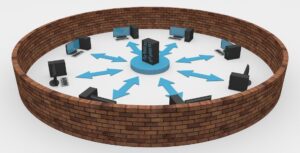
College to Career: Engaging Employers in College Success
Pam Sornson, JD
September 6, 2022
The push to reform America’s higher education system is evolving as technology drives the transformation of our global society. Today’s colleges are changing their strategies away from traditional values and dictates and towards more fundamental economic directives. Their goal now is to facilitate career and job training that supports local and regional economic growth. To attain that goal, universities and colleges must engage with local and regional employers to ensure that students get the occupational training they need to find work and that employers have the well-skilled workforce they require.

A Reconsidered Culture
Perhaps the most significant reason colleges aren’t yet known as ‘workforce development engines’ is that, until very recently, that hasn’t been their role.
The country’s higher education sector began as a series of evangelical schools designed to train missionaries in specific religious doctrines. Over decades, the industry evolved through phases that correlated with the morals and standards of the day, from the development of moral character appropriate for democratic citizenship, to training opportunities for specific professional occupations, to a place where learners could achieve personal economic advantages. Through these years, there were few, if any, interactions between school leadership, policymakers, or even faculty and the local businesses and industries in the communities with which they shared a community.
That communication gap between education and occupation also created a rift in society’s economic foundation. Over time, the skills instilled by university degrees evolved further and further away from the occupational needs of the business community. In turn, the divide has been driving a drop in college enrollment that began early in the 21st century. The National Center for Education Statistics asserts that enrollments in America’s post-secondary institutions grew by 19% from 2006 to 2010 but then fell by 7% from 2010 to 2016. It appears that the overall value of a college education (specifically a four-year university degree) has declined over time as those institutions turn out graduates who are often overqualified for the jobs they ultimately land. (As many as 35% of workforce laborers are considered overqualified, according to Forbes education experts.) In fact, between 1992 and 2010, the number of jobs requiring a bachelor’s degree grew by only 2%, while the percentage of university enrollees grew by 45%. The statistics beg the question, “why is there such a disconnect between the skills needed on the job and the training programs provided by universities and colleges?”

The Short and the Long Answers …
One (of many) short answers is “because employers haven’t yet fully engaged with the higher education community to explain or share their knowledge and occupational standards.”The long answer is “that the disconnect is dissolving as the country’s college system scrutinizes its curricula and community relations practices to achieve better communications with the future employers of its student body.”
This enhanced and growing focus on employer engagement is good news for those business owners, college students, and the economy of their region. The value proposition that such an extensive partnership promises offers each constituent benefits that they cannot gain without the involvement and effort of the others.
According to California Competes, a California State think tank that envisions thriving communities fueled by racially just and equitable workforce outcomes, students, employers, higher Ed institutions, and local economies all benefit greatly when they all focus on achieving common goals.
Students enrolled in occupationally directed training programs receive enhanced clarity about career pathways, readiness skills, and job opportunities and outcomes.
Businesses that contribute to college curricula gain access to larger, better-informed cohort groups of talented students, as well as expanded workforce development programs for their existing staff.
Colleges that actively engage with local businesses achieve a stable enrollment pipeline for students, improved outcomes for their students, and an optimized capacity to contribute to the economic growth of the entire community.
Local economies benefit from these collaborations as the workforce supply and demand gap shrinks, the demand for social safety net services also shrinks, and enhanced civic engagement activities improve local, regional, and state revenues.

… Build True Solutions
Understanding the barriers to communication among these disparate populations helps leaders in each group to forge responses that overcome those hurdles.
In addition to addressing challenges to students (which are many – affordability, access, language, etc.), the Dean’s office must also contemplate how these changes will affect teaching staff contracts, existing curricula, labor and demand statistics, industrial standards, and future growth possibilities.
At the same time, businesses must articulate the skills and abilities they need to perform the workflows that generate their company’s value. Recent technological advances can make these “job descriptions” more difficult to craft.
Finally, local, regional, and state governments must evaluate current rules and regulations that govern but may also inhibit businesses, workforce and labor capacities, and industrial activities.
Dedicated communication practices can help all understand the challenges the others face and collaborate on responses that can address those individual and joint concerns:
Navigating through the varying demands, opportunities, and expectations is easier when the group can identify shared goals and interests and build initiatives based on those common factors.
At the school, leadership should note that full engagement must include more than just upper-level and administrative staff. The faculty, in particular, is a critical player in developing occupationally relevant curricula. Engaging the teaching staff in these conversations is almost mandatory if the “employer engagement” project is to be successful.
Governments can contribute to the work by facilitating readily accessible spaces where these collaborative conversations can occur. Business leaders, industry leaders, school leadership, and even economic development groups can engage in convenient locations to grow communication and economic capacity across them all.
All engaged groups can further the greater project by clarifying and tailoring their individual messaging throughout the community to showcase these shared goals and the values they offer. Joint communications that span multiple media across multiple industries and community sectors build widespread awareness and inclusion and encourage further engagement by the greater community itself.
The emerging community conversation about employer engagement, Community College curricula, and economic development promises to provide solutions to the economic and social challenges posed by the COVID-19 pandemic, un- and under-employed workers, and inequities and inequalities that exist in today’s workforce landscape. At the same time, participants in these collaborations are building a stronger, more resilient, more robust economy that will support today’s and tomorrow’s workforce demand.


